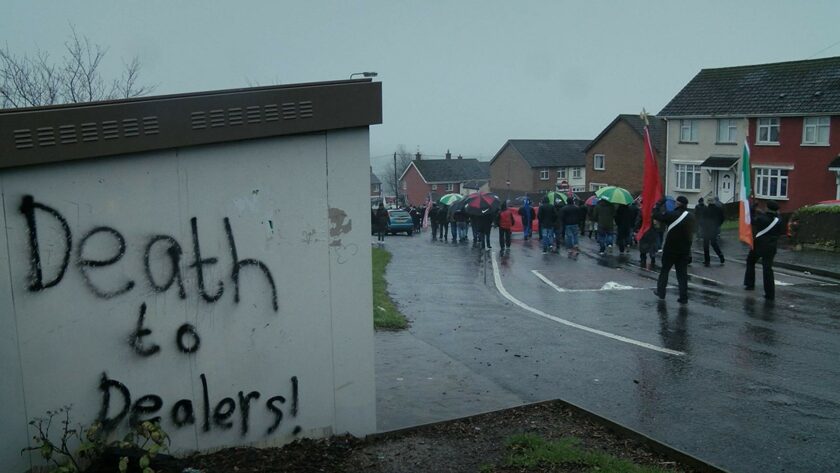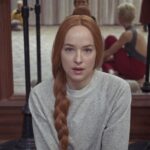Manisha Thind reviews Sinéad O’Shea’s first feature documentary on a troubled Northern Ireland community.
Bleak, grounded and revealing, Sinéad O’Shea’s first feature documentary ‘A Mother Brings her Son to be Shot’ comprehensively voices the story of the O’Donnell family. Living in a housing estate in Free Derry, Northern Ireland, paramilitary groups patrol the streets gathering intelligence and acting as the pseudo-police securing the community. “You are not entering free Derry,” a mural says. The peace process that vowed to deliver opportunities for the young generation and to stop the violence has not produced the fruits it promised. The promise is shattered within the first moments of the film with the sight of an armoured police patrol car passing; a sight more akin to the streets of Palestine than the United Kingdom. Drug abuse plagues the community. Suicide rates have doubled since the Good Friday Agreement of 1998. The young wish for ‘The Troubles’ back out of sheer boredom. Revolutionary sentiments rumble, police-dissident corruption seethes, and above it all violence dominates. The director herself proclaims this documentary as “complicated… grey [and] both funny and dark.”

In short the story stems from one event: the mother, Majella, takes her teenage son, Phillip “Philly” O’Donnell, to a “shooting appointment”. Why? To be kneecapped by Republican dissidents, “The Ra”, for distributing drugs amongst other forms of alleged antisocial behaviour. This was the lesser of two evils; the other option was to be shot in the front garden and be put into a wheelchair. “Death to dealers”, the graffiti proclaims, and that is exactly what Philly dreads to the point of insanity.
The documentary opens with one of Majella’s sons wielding carefree a crowbar, a hatchet, a saw and finally a “torture weapon” – a bolt cutter. Eleven years old, this son, Kevin Barry, is the youngest member of the O’Donnell family. Whilst light-hearted, as a result of the shockingly amusing comments that Kevin makes accompanying his showcase, this scene alludes to the pervasive and cyclical nature of violence in this particular section of the community. Later the camera pans out to reveal Kevin bestowing his expertise on colt M19s and bullets to his mother; again the audience laughs in bewilderment. Comedy, in this documentary, is born out of shock-horror.
The despondency, fear and desolation in Majella’s eyes are representative of the O’Donnell’s situation, the disposition of their community and that of the overall documentary. Through her eyes we can gauge the most honest portrait. Taking diazepam, swallowing bags of powder followed by shots of Sambuca, going six days without sleep, hallucinating, having nightmares about masked men are all things attributed to Philly. He is paranoid, suicidal and psychologically traumatised. And his mother is aware of this. A deep regret clouds Majella – her decision to take her son to be shot. She lives with the knowledge that others call her a bad mother. She knows Philly’s life is still in danger. Yet he returns home in the morning, intoxicated, the shake of his hands immediately recognisable to his mother. Majella is powerless.

This documentary isn’t a political survey of the situation in Derry in the aftermath of ‘The Troubles’ and it doesn’t concern itself with wider political questions. O’Shea herself is delicate in her handling of the political aspect of this documentary being particularly pre-cautious in the use of terminology. Nevertheless, O’Shea subtly yet strikingly alludes to the political alignments of Ireland’s republicans, with Palestine for example, in murals across the region.
During a five-year period of filming, O’Shea has hour-long conversations with the Hugh Brady. This “realist [and] fatalist” was once part of The IRA, then was jailed for sixteen years and now acts as a mediator between The Ra and those in Philly’s predicament. Despite scraping at truths, stating that expelling armed Republicans is still viewed as “informing”, he is a deceitful character to some extent. Ultimately he was expelled from a movement he was committed to after being caught with cannabis and as a result was tied to a lamppost and “painted”. Montages of footage of Brady’s IRA past stress the magnitude of his loyalties and the bias that bleeds into his dialogue. Here it is important to congratulate O’Shea and her team in the thoughtful use of archived footage throughout the documentary.

It was the question and answer session with O’Shea that shed more light on the complexities. O’Shea herself proclaims that it was impossible to determine the truths from the lies during filming. Moreover elements are left out, such as two other siblings in the O’Donnell family; they did not want to appear on camera. This leads to a deficiency in the documentary – the audience doesn’t understand the extent of organised crime in the community. Kevin Barry discloses The Ra are actually taxing the drug trade. Whilst completely plausible it cannot be confirmed; in fact Kevin Barry emerges to be a reflection of his irrational older brother. Why is it plausible? The eldest of the O’Donnell brothers, who is omitted from the documentary, was a bigger drug dealer than Philly yet wasn’t shot. Was he taxed and allowed to carry on with trading in drugs? We don’t know. This dimension alludes to a more cautious O’Shea.
Conceivably the failings of the documentary were to a greater extent a symptom of factors out of O’Shea’s control. The ending is forced to some extent due to the lack of further contact with the O’Donnells. Still, the documentary manages to end on a cyclical note – the father Philip Senior is shot in both knees after being released seven years into a thirteen-year jail-sentence. Again the audience is left wondering as to why. It is only in the plenary session with O’Shea that answers emerge. Hugh, O’Shea tells us, argued that the aforementioned early release was due to Senior passing out information about the cause to the police and then the depositions being released. Senior on the other hand maintains it was due to a brawl or accident. O’Shea then reveals Senior was scarred on his thigh and not on his knees. It is infuriating that conclusions aren’t definitively reached in this documentary and a lack of a robust, objective, outside voice adds to the irritation. Truth is lost somewhere in the estates of Creggan. O’Shea’s narrative is limited and heavily constrained; an interview with a scholar of a related field could’ve added a much needed dimension of clarity.

Although O’Shea can be praised for her patience and dedication spent on the project, this documentary would have benefited with an additional year or more of filming (if funds allowed it of course). Kevin Barry is a refreshing subject in the documentary, and perhaps its true star. As stated previously he provides much comedic relief throughout; he is astonishingly intelligent as well as witty. At fourteen he begins taking drugs outside of cannabis and exhibits anger issues, especially in school, however he is able to channel the rage and aggression into boxing. Towards the end he is shown to be an exact physical copy of Philly implying to some extent a pessimistic future for him. Possibly the greatest tragedy to befall Creggan lies in the loss of Kevin Barry’s potential. The missed focal point in the documentary is the failure of Northern Ireland’s youth to find opportunity; maybe it’s because it is too common a tragedy to register. The documentary itself ends on a doubtful note for the future of the O’Donnells. Upon the film’s release, however, Kevin Barry proceeds to become a building apprentice. If filming had continued longer the documentary could’ve ended on a more positive note – arguably more in line with to actual trajectory of the O’Donnells’ futures.
O’Shea achieves an insight into a small faction of a community still troubled by ‘The Troubles’ themselves. Original in its primary subject matter, it accomplishes by bringing attention to a significant issue within the UK which news outlets don’t pay attention to. Once an invisible community and the people in it disposable, O’Shea manages to expose their realities to some extent. Solidarity against the authority and anarchy stage themselves in the final scene of a bonfire. The peace process hasn’t solved ‘The Troubles’, the war is still not over and a community of people in “Free” Derry continue to live in a post-war prison of violence. The Union Jack burns.
A Mother Brings Her Son To Be Shot was screened at UCL on October 18th. Check out the trailer below:




